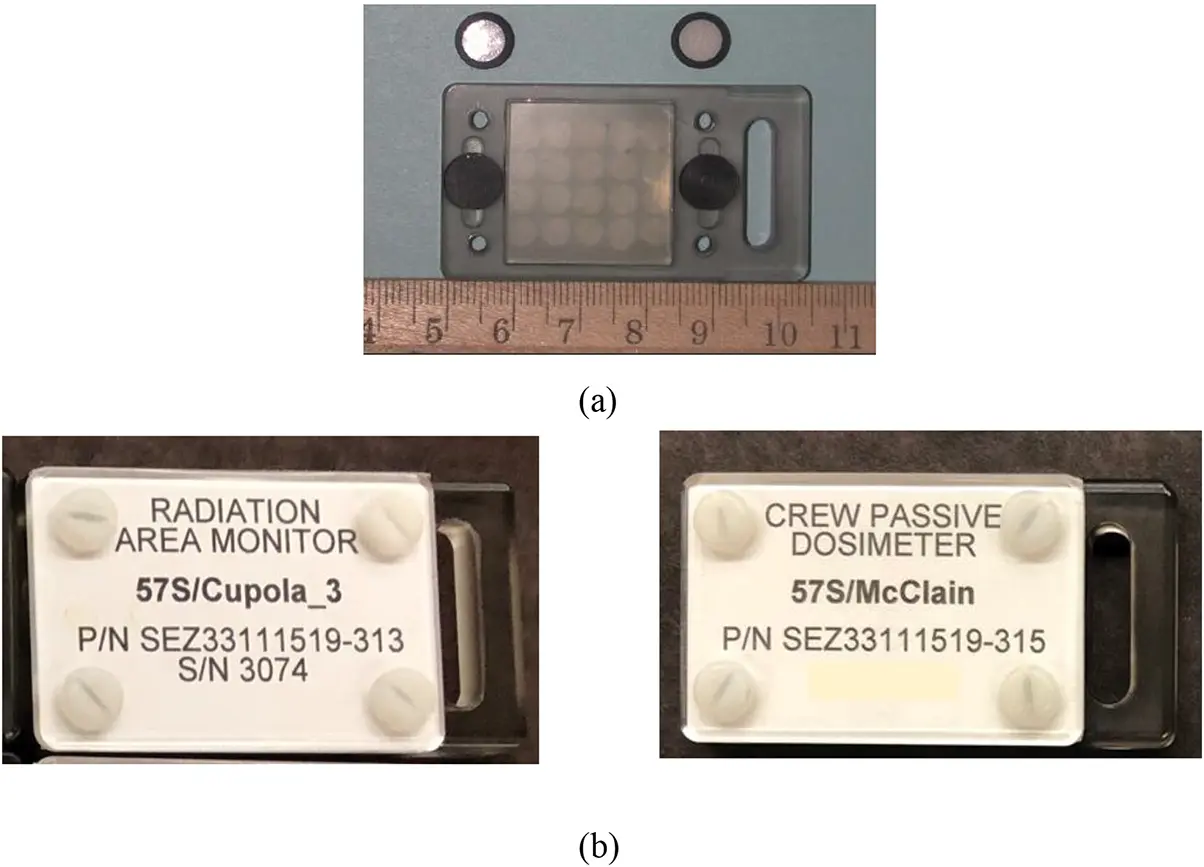1 ...8 9 10 12 13 14 ...18 Commercial TLD materials include those based on LiF (e.g. LiF:Mg,Ti and LiF:Mg,Cu,P), CaF 2(e.g. CaF 2:Mn, CaF 2:Dy, and CaF 2:Tm), Li 2B 4O 7(e.g. Li 2B 4O 7:Cu), MgB 4O 7(e.g. MgB 4O 7:Mn, MgB 4O 7:Dy, and MgB 4O 7:Cu), Al 2O 3(e.g. Al 2O 3:C; Al 2O 3:Si,Ti, and Al 2O 3:Mg,Y) and CaSO 4(e.g. CaSO 4:Tm and CaSO 4:Dy). Other, less well-known and utilized materials have often been described in the published literature, including natural minerals (e.g. calcite, fluorite, quartz). OSLD is dominated by Al 2O 3:C and BeO, while RPLD is dominated by Ag-doped alkali phosphate glass, and Al 2O 3:C,Mg.
The material properties that are important in personal dosimetry are a high sensitivity (large signal for a given dose), a linear dose-response relationship, angle independence, and energy independence. The latter is difficult to achieve at low radiation photon energies. However, the important property in this regard is that the material responds to low-energy photons in the same way as does human tissue – a property known as tissue-equivalence. The most important characteristic for tissue equivalence is the effective atomic number Zeff of the material. Here, materials such as LiF ( Zeff = 8.14), BeO ( Zeff = 7.4) and Li 2B 4O 7( Zeff = 7.13) have advantages over other materials since these values are close to that of tissue ( Zeff = 7.4). However, tissue equivalence is not essential as long as the response at low energies is well defined such that suitable corrections can be made (for example Al 2O 3:C with Zeff = 10.2).
Tissue equivalence is also a desirable characteristic of dosimeters used in medical dosimetry, but not an essential property. The high sensitivity of the TL, OSL, and RPL processes can be exploited in medical dosimetry applications since the dosimeters can be made small, which in turn gives them the property of high spatial resolution. This, in turn, means that they have the potential for dose measurement in regions of severe dose-gradients.
Modern advances in radiation medicine – in radiodiagnosis, radiotherapy, and interventional radiography – are now presenting dosimetry challenges that did not exist previously. For example, the movement toward the use of charged particles (protons and carbon ions) in radiotherapy has resulted in new requirements for luminescence dosimeters compared to the dosimetry of high-energy photons. Known responses to charged particles means careful calibration of the dosimeters in charged-particle fields. This consideration becomes especially significant beyond the Bragg peak for energy deposition by charged particles. Here, the linear energy transfer (LET) of the particles increases rapidly as the particles lose energy and slow down. Knowledge of the behavior of dosimeters in such regions, where the physical dose is rapidly decreasing but the relative efficiency of biological damage (compared to high-energy photons) is rapidly increasing, is a research area of growing importance. Secondary neutron production is also a feature of charged-particle irradiation and the response of the dosimeter in neutron fields also needs to be established.
Sophisticated intensity-modulation techniques in radiotherapy, whether using photons or particles, also create new challenges for dosimetry. This is due to the production of sharp dose gradients where the therapists try to protect healthy tissue surrounding the tumor as much as possible. It is also necessary to understand the response of the dosimeter in either steady or rapidly pulsed radiation fields.
The luminescence dosimeters may be used in vivo or ex vivo. Their small size enables their innovative use internally as the patient is treated (for example, in brachytherapy). The dosimeters may also be used externally to measure entrance and exit doses on the surface of the patient without disturbance of the radiation field.
Luminescence (particularly OSL) has also been used as an imaging technique in radiodiagnosis (where it has long been known by its alternate name of photostimulated luminescence, PSL). The sensitivity and speed of readout of the stimulated luminescence signal has given radiologists the ability to reduce radiation doses to patients and yet provide high-resolution images to aid diagnosis. However, the use of OSL in this way is not dosimetry. The actual dose to the patient is still determined by other methods.
In interventional radiography the real-time dose to patients (and surgeons) during surgical procedures can be significant. Adaptation of OSL techniques using fiber optics can provide dose measurements in real time, without disturbing the x-ray image.
In all of the above applications, the preferred properties of the needed dosimeters include tissue equivalence, high sensitivity, small size, rapid response, and known responses as functions of dose, angle, photon energy, particle LET, and neutrons.
Dosimetry (for astronauts and equipment) in space environments is one of the most challenging applications for luminescence dosimetry. The space environment consists of an extremely wide range of highly energetic charged particles originating from cosmic rays (CR), solar particle events (SPE), and the radiation belts trapped by the Earth’s magnetic field (Earth’s radiation belts, ERB). Additionally, once these particles interact with the spacecraft structures, the astronauts’ space suits, and the astronauts’ bodies, secondary charged particles and neutrons are also produced. Personal and environmental dosimeters for use in space therefore need to respond to an extremely wide-ranging set of particles, each with its own efficiency of luminescence production. The dosimeter’s response to each particle type needs to be well-known and calibrated.
TL dosimeters have been used since the beginnings of human space exploration, in both the American and former Soviet Union programs. More recently, OSL has been used in conjunction with TL in many international space programs. Neither TL nor OSL, however, is able to record dose over the wide range of charged-particle energies and types. The critical parameters are energy, charge, and the linear energy transfer (LET) of the particle. TLD and OSLD materials can record dose in fields of LET up to ~10 keV/ μ m with good efficiency. However, in space, particles of LET values of several hundred keV/ μ m can be expected. The efficiency of TLD and OSLD materials drops significantly as the LET increases beyond ~10 keV/ μ m and, therefore, TLD and OSLD devices are usually used in conjunction with dosimeters such as particle nuclear track detectors (PNTDs), which can measure doses and fluences for individual particles up of these high-LET values, but are insensitive below ~5 keV/ μ m. Thus, techniques to separate the doses in these different regions of the LET spectrum have been devised and used for several years by the various international space agencies. An example of a personal dosimeter used by the US National Aeronautics and Space Administration (NASA) is shown in Figure 1.6 and features LiF:Mg,Ti TL dosimeters, Al 2O 3:C OSL dosimeters and PNTD using a polycarbonate plastic known as CR-39. RPLD using Al 2O 3:C,Mg may have a future application in space as a PNTD, at least as a research tool.

Figure 1.6 (a) NASA’s passive radiation area monitor (RAM), and (b) Radiation Area Monitor (RAM) and Crew Passive Dosimeter (CPD). Each consists of 20 TL dosimeters (LiF:Mg,Ti), two OSL dosimeters (Al 2O 3:C) and one PNTD (CR-39). In Figure 1.6a the TL dosimeters can be seen underneath the PNTD film, and the OSL dosimeters are inside the circular, black, Teflon holders. Source: NASA; reproduced with permission from NASA Export Control.
Читать дальше













